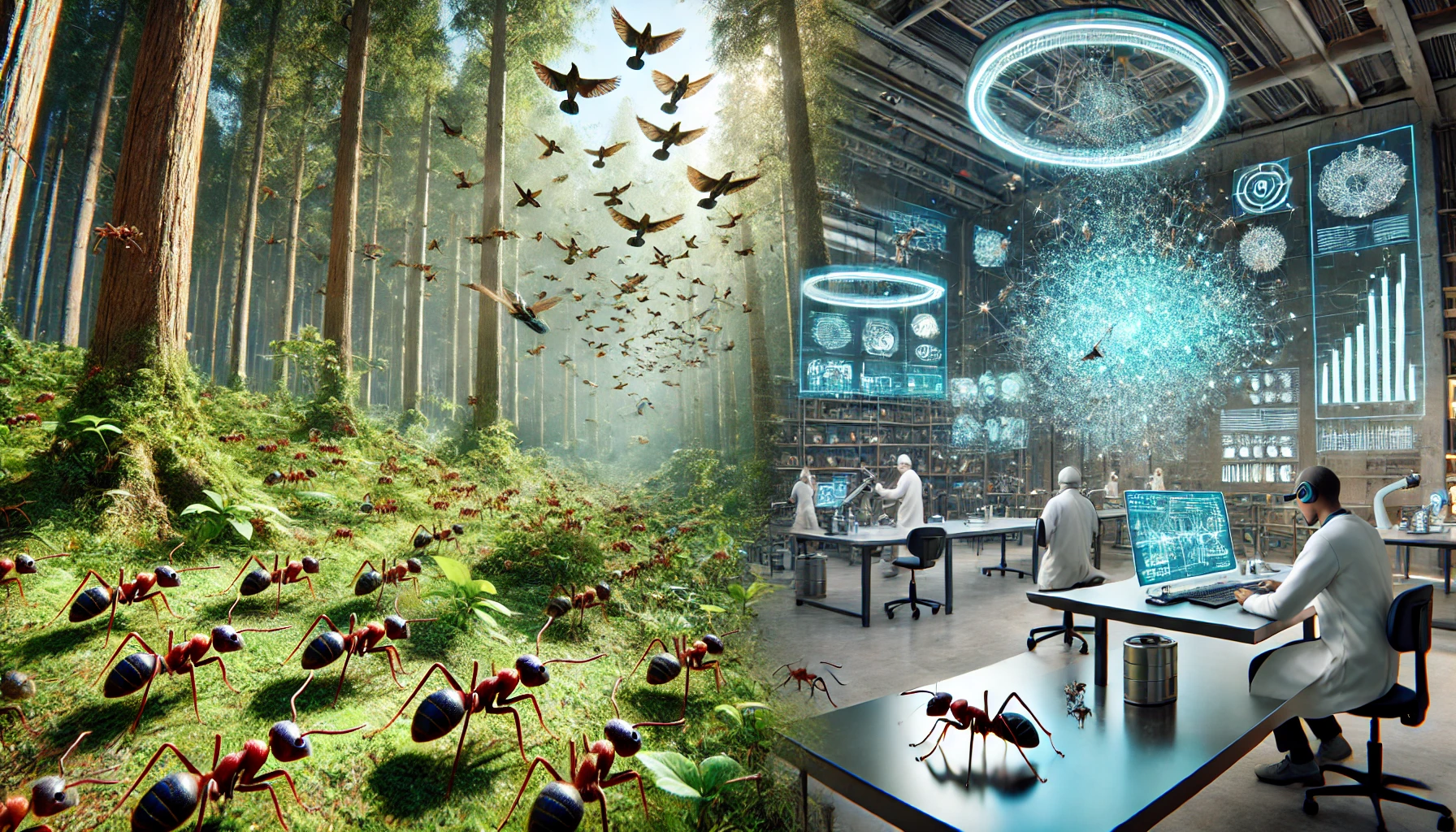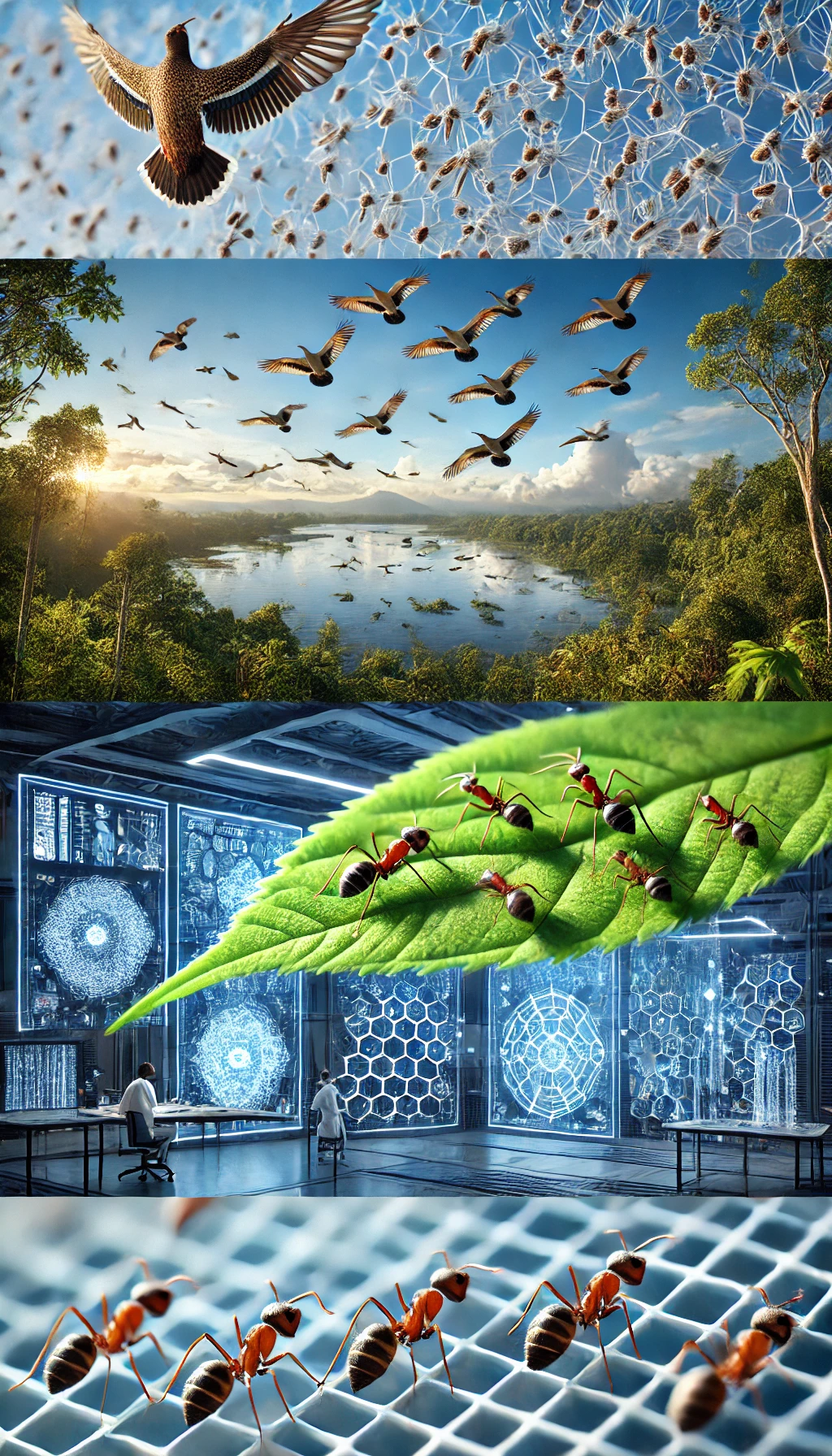
Swarm Intelligence: Emergent Problem-Solving in Complex Systems
Published on: January 3, 2025
In nature, countless examples demonstrate how individual agents operating under simple rules can collectively solve complex problems. From the coordinated foraging behavior of ants to the dynamic formations of bird flocks, these natural phenomena have inspired a field of study known as swarm intelligence. By mimicking the decentralized and self-organized nature of these biological systems, researchers and engineers have developed algorithms that solve problems in optimization, machine learning, robotics, and beyond. This article explores the principles behind swarm intelligence, its applications across various industries, and how it continues to shape the future of problem-solving in complex systems.
What Is Swarm Intelligence?
Swarm intelligence refers to the collective behavior of decentralized, self-organized systems, typically composed of numerous simple agents interacting locally with one another and their environment. These agents lack centralized control, yet their interactions result in the emergence of coherent global behavior.
The term "swarm intelligence" was first introduced by Gerardo Beni and Jing Wang in 1989, in the context of cellular robotic systems. Since then, the concept has expanded to include various algorithms inspired by the collective behavior of social animals, such as ants, bees, fish, and birds.
Key characteristics of swarm intelligence include:
- Self-Organization: Agents operate based on local rules without a central authority dictating their actions.
- Emergence: Complex global patterns arise from the local interactions of agents.
- Robustness: The system can function effectively even if individual agents fail.
- Scalability: Swarm systems can adapt to different sizes and complexities.
Swarm intelligence systems have been found to work well in dynamic environments, where changes occur rapidly and unpredictably. These systems are also known for their inherent ability to learn and adapt, making them an ideal choice for tasks requiring continuous optimization and real-time decision-making. Whether in natural ecosystems or artificial environments, swarm intelligence offers an unparalleled approach to decentralized problem-solving.
Biological Inspirations Behind Swarm Algorithms
The study of swarm intelligence draws heavily on the behavior of social animals. Here are some of the most influential biological systems:
Ant Colonies
Ants are known for their remarkable ability to find the shortest paths to food sources. They achieve this through a mechanism called pheromone trails. As ants move, they deposit pheromones, which other ants can detect and follow. Over time, shorter paths accumulate more pheromone, guiding the colony toward optimal routes.
This behavior inspired the Ant Colony Optimization (ACO) algorithm, which solves combinatorial optimization problems such as the traveling salesman problem, network routing, and scheduling. The decentralized nature of ant colonies ensures robustness and adaptability, as the failure of a single ant does not disrupt the overall functioning of the colony.
Bee Swarms
Honeybees exhibit sophisticated decision-making processes when searching for new hive locations. Scout bees perform a "waggle dance" to communicate the quality and direction of potential sites. This collective decision-making mechanism ensures that the colony selects the most suitable site.
The Artificial Bee Colony (ABC) algorithm, inspired by this behavior, has been applied to numerical optimization problems and machine learning. The use of ABC in real-world applications has expanded significantly, including areas such as environmental monitoring and agricultural optimization.
Bird Flocks and Fish Schools
Flocking birds and schooling fish demonstrate coordinated movement without centralized control. Each individual adjusts its behavior based on the positions and velocities of its neighbors, resulting in cohesive group dynamics.
Algorithms such as Particle Swarm Optimization (PSO) emulate this behavior to solve optimization problems. PSO involves a population of candidate solutions (particles) that adjust their positions in the search space based on their own experience and that of their neighbors. Unlike traditional optimization methods, PSO leverages social sharing of information to enhance the search process.
Beyond optimization, models of bird flocking have inspired new methods for autonomous vehicle navigation and crowd simulation. The ability of these models to simulate large groups efficiently makes them invaluable in urban planning, disaster management, and virtual reality environments.
Swarm Intelligence Algorithms
Several algorithms have been developed based on the principles of swarm intelligence. Below are some of the most prominent ones:
Ant Colony Optimization (ACO)
ACO is particularly useful for solving discrete optimization problems. The algorithm involves the following steps:
- Initialization: A population of artificial ants is placed on a graph representing the problem.
- Exploration: Ants explore the graph, depositing pheromones on the edges they traverse.
- Pheromone Update: The pheromone levels are updated based on the quality of the solutions found.
- Iteration: The process repeats, gradually improving the solution.
Applications of ACO include:
- Vehicle routing
- Network optimization
- Scheduling and resource allocation
Recent advancements in ACO have led to hybrid models that combine ACO with other optimization techniques, such as genetic algorithms and simulated annealing. These hybrid approaches have demonstrated superior performance in complex, large-scale problems.
Particle Swarm Optimization (PSO)
PSO is a population-based optimization technique inspired by the social behavior of bird flocks and fish schools. Each particle represents a potential solution and adjusts its position based on its own best-known position and that of its neighbors.
The key steps in PSO are:
- Initialization: A swarm of particles is randomly initialized.
- Evaluation: Each particle’s fitness is evaluated based on the objective function.
- Update: Particles update their positions and velocities based on personal and global best solutions.
- Iteration: The process continues until a stopping criterion is met.
PSO has been applied to:
- Function optimization
- Neural network training
- Control system design
Modern PSO variants include multi-objective PSO and adaptive PSO, which dynamically adjust parameters during the search process. These variants have expanded the applicability of PSO to multi-criteria decision-making and dynamic optimization environments.
Artificial Bee Colony (ABC)
ABC is an optimization algorithm inspired by the foraging behavior of honeybees. It consists of three types of bees:
- Employed Bees: Search for food sources and share information with onlooker bees.
- Onlooker Bees: Choose food sources based on the information provided by employed bees.
- Scout Bees: Explore new areas randomly when food sources are exhausted.
ABC has been used for:
- Numerical optimization
- Image segmentation
- Data clustering
Recent research on ABC focuses on improving convergence speed and solution accuracy. Techniques such as chaotic maps and adaptive strategies have been proposed to enhance the performance of ABC in highly complex search spaces.
Applications of Swarm Intelligence
The decentralized, self-organized nature of swarm intelligence makes it suitable for a wide range of applications across various industries. Here are some notable examples:
Logistics and Supply Chain Optimization
Swarm intelligence algorithms are used to optimize logistics and supply chain management by finding the most efficient routes and schedules. For example:
- Vehicle Routing: ACO and PSO algorithms can be used to determine optimal delivery routes, minimizing fuel consumption and delivery time.
- Warehouse Management: Swarm-based approaches help in optimizing the layout and operations within warehouses.
- Inventory Management: Swarm algorithms assist in maintaining optimal stock levels by predicting demand patterns and coordinating replenishment schedules.
Robotics
Swarm robotics involves the coordination of multiple robots to perform tasks collectively. These robots operate based on simple rules and local interactions, enabling them to achieve complex goals without centralized control.
Applications include:
- Search and Rescue: Swarm robots can be deployed in disaster areas to search for survivors.
- Agriculture: Autonomous drones can collaborate to monitor and manage crops.
- Exploration: Swarm robotics is being explored for space missions, where multiple small robots could work together to explore planetary surfaces.
Advances in swarm robotics have led to the development of micro-robots capable of operating in harsh environments, such as deep-sea exploration and radioactive zones. These robots can work collectively to gather data and perform maintenance tasks in places that are inaccessible or dangerous for humans.
Telecommunications
In telecommunications, swarm intelligence is used to optimize network routing and resource allocation. For example:
- Mobile Ad Hoc Networks (MANETs): ACO and PSO algorithms are applied to optimize routing in dynamic, decentralized networks.
- Spectrum Management: Swarm algorithms help in dynamically allocating spectrum resources in wireless networks.
Swarm-based approaches are also being explored for 5G and beyond networks, where efficient resource allocation and low-latency communication are critical. By enabling real-time optimization, swarm intelligence can enhance the quality of service and reduce operational costs.
Financial Modeling
Swarm intelligence algorithms are used in financial markets for tasks such as portfolio optimization, risk assessment, and algorithmic trading. By simulating the behavior of market participants, swarm models can provide insights into market dynamics.
Recent studies have demonstrated the potential of swarm-based approaches in detecting market anomalies and predicting price movements. These approaches leverage the collective intelligence of distributed models to improve forecasting accuracy.
Healthcare
Swarm intelligence has found applications in healthcare for:
- Medical Imaging: Algorithms such as PSO and ABC are used for image segmentation and feature extraction.
- Drug Discovery: Swarm-based approaches help in searching large chemical databases for potential drug candidates.
- Disease Diagnosis: Machine learning models optimized using swarm algorithms improve the accuracy of diagnostic systems.
In addition, swarm robotics is being explored for minimally invasive surgery, where micro-robots can collaborate to perform complex procedures with high precision. The use of swarm intelligence in personalized medicine is also gaining traction, with algorithms helping to tailor treatments based on individual patient data.
Advantages and Challenges
Advantages:
- Flexibility: Swarm systems can adapt to dynamic environments.
- Scalability: These systems can handle varying numbers of agents and problem sizes.
- Robustness: The decentralized nature makes them resilient to individual failures.
- Adaptability: Swarm systems can learn from experience and improve their performance over time.
Challenges:
- Convergence: Ensuring that the system converges to an optimal solution can be difficult.
- Complexity: Modeling and analyzing swarm systems can be computationally intensive.
- Parameter Tuning: Many swarm algorithms require careful tuning of parameters to achieve good performance.
- Communication Overhead: In large-scale systems, maintaining effective communication among agents can be a challenge.
Future Directions
As technology advances, swarm intelligence continues to evolve, with promising future directions:
- Hybrid Algorithms: Combining swarm intelligence with other optimization techniques, such as genetic algorithms and deep learning, can improve performance.
- Real-Time Applications: Developing swarm algorithms capable of operating in real-time is crucial for applications such as autonomous vehicles and robotics.
- Quantum Swarm Intelligence: The integration of swarm intelligence with quantum computing holds potential for solving even more complex problems.
- Bio-Inspired Hardware: Advances in hardware, such as neuromorphic computing, may enable the development of physical systems that directly implement swarm algorithms.
- Ethical Swarm Systems: Ensuring that swarm-based systems operate ethically, particularly in autonomous applications such as drones and self-driving cars, is an emerging area of research.
Swarm intelligence represents a paradigm shift in problem-solving, leveraging simple local interactions to achieve complex global behavior. Its applications span a wide range of fields, from logistics and robotics to finance and healthcare. As researchers continue to draw inspiration from nature and develop more sophisticated algorithms, swarm intelligence is poised to play a pivotal role in shaping the future of technology and society. By understanding and harnessing the principles of self-organization, emergence, and collective behavior, we can build systems that are more resilient, efficient, and capable of tackling the world's most complex challenges.
Whether through autonomous drones optimizing delivery routes, micro-robots collaborating on medical procedures, or advanced networks dynamically allocating resources, the potential of swarm intelligence is vast. As this field continues to grow, it holds the promise of revolutionizing how we approach problem-solving in an increasingly complex world.
